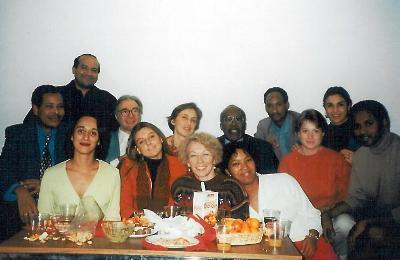Stories
National culture of peace programmes
Missions for the culture of peace
The failure of the culture of peace programme
Brothers for Peace
* * *
Fearing that the UN sponsorship of the Gulf War was a step toward use of the UN by the United States and its allies for a global tyranny, I took my sabbatical from Wesleyan to go to UNESCO and develop an alternative to UN military intervention.
My proposal for a culture of peace programme was accepted and over the next few years I worked on it at UNESCO, first as a consultant and then as a staff member. Eventually the moment arrived when I had to give up my post at Wesleyan. It was a harrowing moment because I did not yet have confirmation of a post at UNESCO. In fact, to this day, I don't know how the Director-General got me the post because he by-passed the usual procedures.
These were difficult years for my marriage, as Lindsay remained in the US for the first few years and we did not see each other for months at a time. Eventually, we were helped to save the marriage by a wonderful counsellor named Edith Perrow, and Lindsay came over in 1995 and we got a great apartment on the corner of rue de Champs de Mars and Avenue Bosquet with views of the Eiffel Tower one way, UNESCO another way, and Montmarte yet another.

The team of the culture of peace unit in 1997
click on photo to enlarge and to read names
I came to know many wonderful people in the course of my work at UNESCO: not only Federico Mayor, but also many people at a grassroots level. My work on national programs would have been impossible except for my "brothers for peace", Francisco Lacayo and Noel Chicuecue. Perhaps the most special were a couple of Africans, Malangatana and Nestor Bidadanure.
Working on the culture of peace at UNESCO was an up-and-down sleigh ride of hopes and despairs, victories and defeats, leading ultimately to the failure of the programme. I recognized its failure by the end of 1996, long before others would admit it, and wrote a long essay to clarify my analysis, which I did not show to anyone else, but which I now publish for the first time as Lessons Drawn from Failures of the Culture of Peace Programme 1993-1996. Although there were frequent bureaucratic obstacles, to the point that I referred to them as crabs, the principle obstacles were political. One of the worst was about the monograph that I wrote for UNESCO, entitled UNESCO and a Culture of Peace. It was illustrated with drawings from Mozambique, Costa Rica and France and formatted brilliantly by Susanne Almeida-Klein. Published in 1995, it was so effective that Director-General Mayor kept a stack of them in his office to give to diplomats and heads of state. But the crabs were so jealous that they had to destroy it. My boss at the time, Leslie Atherley, hired a young woman to make a new version which was then published to replace the original book. They removed all the illustrations and formatting and the best parts of the text, especially its conclusion.
From this point on, there is abundant documentation of my work. There is a series of large brown notebooks beginning in 1992, extending through volume 29 in 2006, the archives of the culture of peace from UNESCO with approximately 5000 pages of documents and an annotated bibliography (see the years 1992-2001 in the bibliography folder of this autobiography), deposited at Wesleyan University, and a brief history of the culture of peace, on line at http://www.culture-of-peace.info/history/introduction.html. In addition there are five containers at my apartment arranged in chronological order with still further documentation. To give some idea, here are the national peace programmes in El Salvador and Mozambique.
At the same time as it was a failure, the Culture of Peace Programme opened a unique and amazing window into the workings of history. In five short years, I became involved in and came to understand the political, historical processes at every level, from the halls of the United Nations to the villages of Mozambique and El Salvador. On the basis of the understanding I gained through this remarkable experience, I could later formulate the Global Movement for a Culture of Peace and a strategy for revolution in the 21st Century. And, most important, I was able to move on to an even more challenging position at UNESCO in charge of the International Year for the Culture of Peace.
 |
Stages
1986-1992
Fall of Soviet Empire
1992-1997
UNESCO Culture of Peace Programme